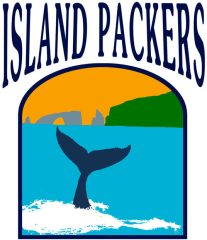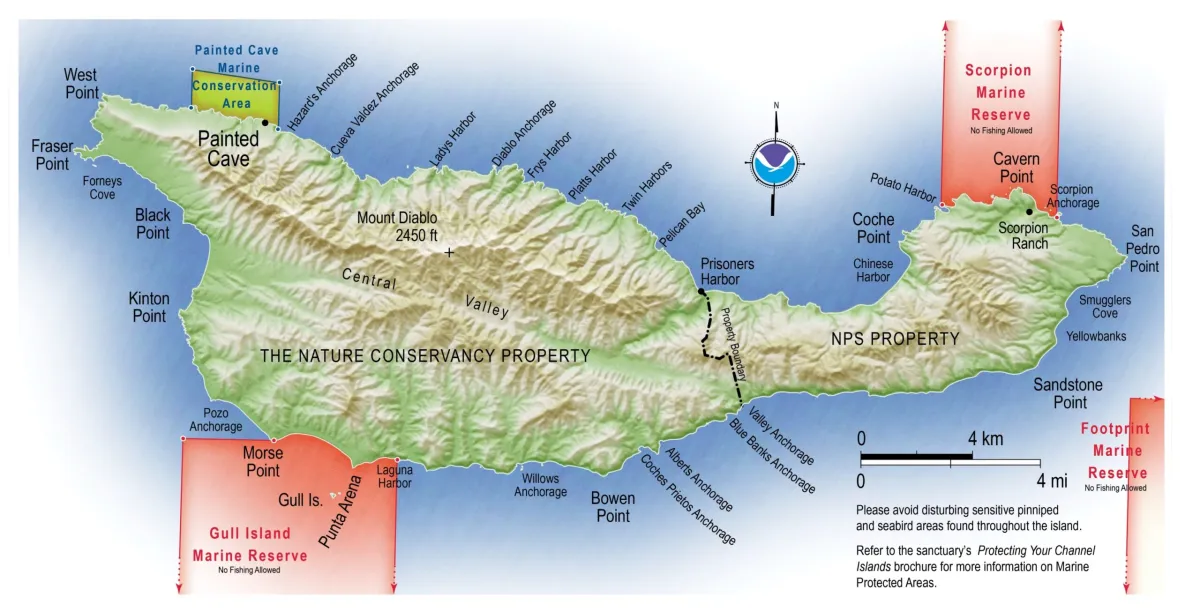ABOUT SANTA CRUZ ISLAND
Santa Cruz Island is the largest of all the Channel Islands (and California!) At over 24 miles long and six miles at its widest, Santa Cruz has over 62,000 acres (96 square miles) and 77 miles of shoreline. Santa Cruz Island lies approximately 20 miles offshore from Ventura Harbor.
Santa Cruz Island offers two primary landing sites which the vast majority of guests to the island visit. Both landings are situated on the closer, northern side of the island. Scorpion Anchorage on NPS property, lies on the east end of the island, and Prisoners Harbor to the west, at the border of National Park and The Nature Conservancy property.
Travel time to Scorpion is a little over an hour and Prisoners Harbor, on direct route is about one and a half hours. Frequently, our boats land at Scorpion Anchorage to offload passengers and gear before continuing to Prisoners Harbor. On these trips travel time to Prisoners Harbor can be 2 hours or more with a beautiful cruise along the rugged shoreline of Santa Cruz Island.
Click Map for a Larger View 🔍
-
Island Packers Travels to Scorpion Anchorage Year Round.
- Summer – April through October: Seven days a week
- Winter – December through March: Tuesday, Friday, Saturday & Sunday
- Closed Thanksgiving & 12/25
-
Santa Cruz Island at both Scorpion Cove and Prisoners Harbor have a sand and rocky beach. Visitors who want to access the ocean for swimming, snorkeling or kayaking are advised to bring a pair of water shoes. The addition of water shoes will make your ocean experience much more enjoyable.
Facilities - Scorpion Anchorage
Potable water is available in the campground area. Vault style restrooms are located near the beach and two in the campground area.
Picnic tables are located near the beach and in the Visitors Center area. A 31-site campground area begins one mile from the pier and is an easy flat walk.
Facilities - Prisoners Harbor
There is NO potable water available at Prisoners Harbor. Vault style restrooms are located near the beach. Picnic tables are located near the pier, and 1.3 uphill miles at the Del Norte trail head.
There is no Visitors Center at Prisoner’s. Four 4-man campsites are located 3.5 miles up the trail above the cove with beautiful overlooks. This is back country camping.
Topography
At over 96 square miles, Santa Cruz is the largest island in the Park. Santa Cruz includes three mountain ranges.
The highest peak of all the Channel Islands (Mount Diablo rising above 2000 feet,) a large central valley/fault system, deep canyons with year round springs and streams, and 77 miles of craggy coastline cliffs, giant sea caves, pristine tide pools and expansive beaches.
About the Island
These varied land forms support a wide variety of plant and animal species. More than 600 plant species have been documented in ten different plant communities from marsh and grasslands to chaparral and pine forests.
There are 140 species of land birds, 11 land mammal species, three amphibian and five reptile species. Large colonies of nesting sea birds, breeding seals and sea lions, and other diverse marine plants and animals can often be seen during transit to the island and from mainland.
Flora & Fauna
From millions of years of isolation, many distinctive plants and animal species have adapted to the island’s unique environments. Notably, the island scrub-jay, the Santa Cruz Island fox and eight plant species are found on Santa Cruz and nowhere else in the world (endemics).
You can view the endemic Santa Cruz Island Scrub Jay year-round: an easy stroll up the dirt road to the old stream bed at Prisoners Harbor or a rugged hike up Scorpion Canyon should provide a viewing opportunity year-round.
Cultural History
The island is exceptionally rich in cultural history with evidence of over 13,000 years of Chumash people habitation and over 150 years of European exploration.
Remnants of the ranching era also can be seen throughout the landscape of the island. Adobe ranch houses, barns, blacksmith and saddle shops, wineries, and a chapel all attest to the many uses of Santa Cruz in the 1800 and 1900s.
SCORPION ANCHORAGE INFORMATION
About Scorpion Anchorage
Once underway the channel crossing takes about one hour, longer if we encounter marine life along the way.
There are vault style restrooms, tree shaded picnic tables and potable drinking water available at Scorpion Anchorage.
There is plenty to discover on a Scorpion Anchorage Day Trip, beginning with a visit to the island visitors center located at historic Scorpion Ranch. Panel displays, exhibits and a topographic relief map describe the vast bio-diversity and rich cultural history of Santa Cruz Island.
Hiking Scorpion Anchorage
Scorpion Anchorage offers some of the most varied trails, from family hikes to strenuous trails for the avid hiker. A guided hike by a volunteer National Park naturalist is offered on most day trips. The guided hike is on the Cavern Point Trail at no charge.
The Beach
You can swim or snorkel through shoreline kelp forests or just relax on the cobblestone beach. Coastal kayaking along the cave pocketed volcanic cliffs is a popular exploration of kayaking enthusiasts.
Day Trip Preparation
What You Need to Know & Bring• Please arrive at your harbor of departure 45 minutes before your scheduled mainland departure.
• Pack food and drink for your time on the island. A small cooler with a single handle or a backpack will help to protect your food from the small animals and birds that populate the islands year-round. There are no shops or restaurants on the island.
• Fresh/Potable water is available in the campsite area.
• Visitors to the island must take all their trash with them when they depart the island.
• Flat shoes with rubber soles are best for both the boat and the island. We recommend hiking shoes. We suggest passengers do not wear loose or leather soled sandals or flip flops on your island adventure.
• Weather conditions can change rapidly in the Santa Barbara Channel. It is always best to dress in layers and bring a jacket/sweatshirt (even in the summer months).
• Shade is available in the Scorpion Ranch area. There is no shade on trail. Hat and sunscreen is recommended even on overcast days.
PRISONERS HARBOR INFORMATION
Hiking Prisoners Harbor
Prisoners Harbor offers hiking trail options from short, level-ground walks, to truly strenuous hikes. A guided trek by an Island Packer naturalist is offered on most day trips. These hikes often travel the scenic, 4-mile trail from Prisoner’s Harbor towards Pelican Bay. There is no charge for naturalist-led hikes:
Self Guided Trail Options:
• Eagle Canyon Picnic Area: Less than a half mile one way – Enjoy a brief walk up the Navy Road to a picnic area that has beautiful views of Prisoner’s Harbor.
• Del Norte Trailhead: .3 miles one way – Take a longer walk to the campground trail head, where the picnic area faces Chinese Harbor and the mainland beyond.
• South Side Overlook: 2.5 miles one way – For the more adventurous, this uphill climb will leave you breathless with awe at the incredible panoramic view. On a clear day, you can see San Nicholas Island, Santa Barbara Island, and Santa Catalina Island out to the south.
Day Trip Preparation
What You Need to Know & Bring• Please arrive at your harbor of departure 45 minutes before your scheduled mainland departure.
• Pack food and drink for your time on the island. A small cooler with a single handle or a backpack will help to protect your food from the small animals and birds that populate the islands year-round. There are no shops or restaurants on the island.
• There is NO FRESH/Potable water at this area of the island. You must bring water with you for your requirements.
• Visitors to the island must take all their trash with them when they depart the island.
• Flat shoes with rubber soles are best for both the boat and the island. We recommend hiking shoes. We suggest passengers do not wear loose or leather soled sandals or flip flops on your island adventure.
• Weather conditions can change rapidly in the Santa Barbara Channel. It is always best to dress in layers and bring a jacket/sweatshirt (even in the summer months).
• Shade is available in some of the picnic area. Most trails have little or no shade. A hat and sunscreen are recommended.
• A second pair of shoes or water shoes are recommended for the cobblestone beach, for foot protection, if you are planning to get into the water.
Pelican Bay Trail Guided Hike
Travelers visiting Prisoner’s Harbor on Santa Cruz Island have the option to participate in a rewarding, rugged hike along the Pelican Bay Trail. These hikes are escorted by an Island Packer naturalist along coastal bluffs, and through pine tree groves, oak trees, and multiple deep canyons. Scenic views and an excellent opportunity to spy unique wildlife highlight this strenuous hike along the wetter northwest portion of the island.
In springtime, the island’s plants and flowers burst with stunning colors and bird life is plentiful. Visitors have an excellent chance to see the bright blue Island Scrub Jay, which is an endemic species found only on Santa Cruz Island. Other year-round endemic species frequently found when hiking this trail include the Santa Cruz Island Fox.
Persons who participate in this guided hike must complete and sign a TNC Release form which Island Packers provides. You may also download the release form.
This hike is not a destination hike to Pelican Bay, but a guided hike through this pristine area along the Pelican Bay Trail. Hikers should not expect to reach Pelican Bay on this hike. Group size and hiker fitness will determine how far along the trail we can go before heading back to meet the boat.
Visitors to Prisoner’s Harbor can join the guided hike, hike on their own, swim in the ocean, enjoy the pier, snorkel, or just relax on the cobblestone beach. Coastal kayaking is also a popular activity for kayaking enthusiasts. Fishing is allowed in this area with all required California Fish & Game licensing.
Visitors intending to hike on the Pelican Bay Trail should be prepared. There is no water or other supplies available at Prisoners Harbor. Visitors need to arrive in the morning with all food, drink, and personal supplies they will need for the day. Amenities at Prisoner’s Harbor include a pit toilet near the landing but no other services.
Activities
Visitors to Prisoner’s Harbor can join the guided hike, hike on their own, swim in the ocean, enjoy the pier, snorkel through shoreline kelp forests, or just relax on the cobblestone beach. Coastal kayaking is another popular exploration for kayaking enthusiasts. Fishing is allowed in this area with all required California Fish & Game licensing.
Wildlife Viewing
Wildlife Highlights of Santa Cruz Island – Prisoners Harbor
For wildlife enthusiasts, a day trip to Prisoners Harbor on Santa Cruz Island offers a rare opportunity to encounter species found nowhere else on Earth. The endemic Island Fox, once endangered and now a conservation success story, can often be spotted near trails and underbrush. Equally special is the Santa Cruz Island Scrub Jay, a vivid blue bird with a call as distinctive as its plumage, best seen by walking the dirt road to the old streambed or exploring more rugged terrain like Scorpion Canyon.
From February through April, the island’s grasslands turn lush and green, and wildflowers like island buckwheat and native asters come into full bloom. The Prisoners Harbor to Pelican Bay trail is a top spot for springtime floral displays, attracting a variety of pollinators and offering vibrant views. Wildflower displays vary year to year, depending on seasonal rainfall and temperatures.
The island’s rich marine environment is equally rewarding. During the summer and fall, calm seas make conditions ideal for snorkeling and kayaking through the vibrant kelp forests just offshore. These waters also become a migratory highway for whales—keep an eye out for Blue and Humpback Whales during your ferry ride to or from the island.
Whether exploring on foot or by sea, Prisoners Harbor is a haven for endemic species and natural beauty year-round.
SEASONAL HIGHLIGHTS
-

December through mid- February, southbound migrating Gray Whales can often be observed from Cavern point on East Santa Cruz or the bluffs of Mid Santa Cruz as the whales pass near the island. During the northbound direction of their journey, they frequently pass closer to the mainland. December through Mid April many channel crossings provide the opportunity to view gray whales.
-

February through April, the grasslands of Santa Cruz Island are green and the native flowers in bloom. Scorpion Canyon and the Potato Harbor trail are excellent places to see wildflowers. The Prisoners Harbor to Pelican Bay trail has some of the best wildflower displays on the island. Intensity and duration of the bloom differs a bit each year due to varied rainfall and temperature. Many Channel crossings this time of year include Gray Whale sightings.
-
 Sea conditions during summer and early fall are often ideal for kayaking and snorkeling. Sea temperatures during warmer months may reach the upper 60’s. Endemic island wildflowers including island buckwheat and asters are in bloom. During summer months, there a chance to see Blue or Humpback Whales in the deep water, during travels to and from Santa Cruz Island.
Sea conditions during summer and early fall are often ideal for kayaking and snorkeling. Sea temperatures during warmer months may reach the upper 60’s. Endemic island wildflowers including island buckwheat and asters are in bloom. During summer months, there a chance to see Blue or Humpback Whales in the deep water, during travels to and from Santa Cruz Island. -
 A late “Second Summer” season is often enjoyed on the Channel Islands. Sea conditions are generally agreeable, crowds are fewer and pleasant weather is the norm. Locals often wait for October to head out to the islands.
A late “Second Summer” season is often enjoyed on the Channel Islands. Sea conditions are generally agreeable, crowds are fewer and pleasant weather is the norm. Locals often wait for October to head out to the islands.
ADDITIONAL INFORMATION
SCORPION ANCHORAGE PHOTO GALLERY
-
Photo by Diane Edmond
-
Photo by Doug Mangum
-
Photo by Dan Harding
-
Photo by Chuck Graham
-
Photo by Diane Edmond
-
Photo by Doug Mangum
-
Photo by Chris Pomaski
-
Photo by CWC
-
Photo by Diane Edmonds
-
Photo by Diane Edmond
-
Photo by Diane Edmond
-
Photo by Diane Edmond
-
Photo by Doug Mangum
-
Photo by Doug Mangum
-
Photo by Doug Mangum
-
Photo by Doug Mangum
-
Photo by Doug Mangum
-
Photo by Doug Mangum
-
Photo by Doug Mangum
-
Photo by Doug Mangum
-
Photo by Doug Mangum
-
Photo by Doug Mangum
-
Photo by Doug Mangum
-
Photo by Doug Mangum
-
Photo by Doug Mangum
-
Photo by Doug Mangum
-
Photo by Doug Mangum
-
Photo by Hilda Kilpatrick
-
Photo by Hilda Kilpatrick
-
Photo by Hilda Kilpatrick
-
Photo by Lotti Keenan
-
Photo by Lotti Keenan
-
Photo by Lotti Keenan
-
Photo by Lotti Keenan
-
Photo by Lotti Keenan
-
Photo by Lotti Keenan
PRISONERS HARBOR PHOTO GALLERY
-
Photo by Chuck Graham
-
Photo by Chuck Graham
-
Photo by Chuck Graham
-
Photo by Chuck Graham
-
Photo by Chuck Graham
-
Photo by Chuck Graham
-
Photo by Chuck Graham
-
Photo by Chuck Graham
-
Photo by Chuck Graham
-
Photo by Chuck Graham
-
Photo by Chuck Graham
-
Photo by Chuck Graham
-
Photo by Chuck Graham
-
Photo by Chuck Graham
-
Photo by Donald Davidson
-
Photo by Diane Edmonds
-
Photo by Diane Edmonds
-
Photo by Diane Edmonds
-
Photo by Diane Edmonds
-
Photo by Diane Edmonds
-
Photo by Diane Edmonds
-
Photo by Dan Harding
-
Photo by Dan Harding
-
Photo by Dan Harding
-
Photo by Dan Harding
-
Photo by Dan Harding
-
Photo by Doug Mangum
-
Photo by Doug Mangum
-
Photo by Tim Hauf
-
Photo by Doug Mangum
-
Pelican Trail View Photo by Doug Mangum
-
Photo by Doug Mangum
-
Photo by Doug Mangum
-
Photo by Doug Mangum
-
Photo by Doug Mangum
-
Photo by Ralph Custodio
-
Photo by Ralph Custodio
-
Photo by Tim Hauf
-
Photo by Tim Hauf
-
Photo by Tim Hauf
-
Photo by Tim Hauf
-
Photo by Tim Hauf


